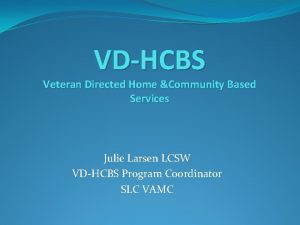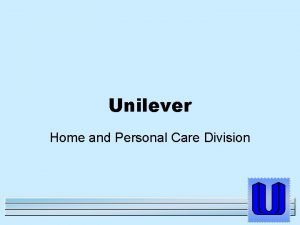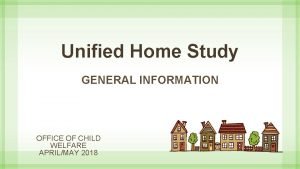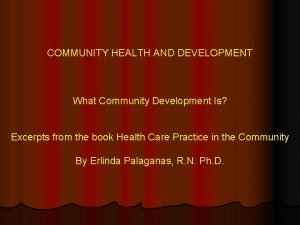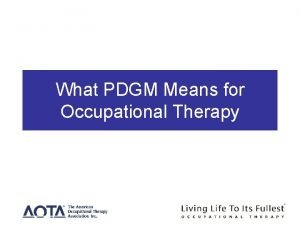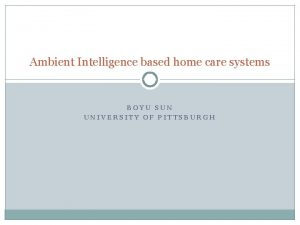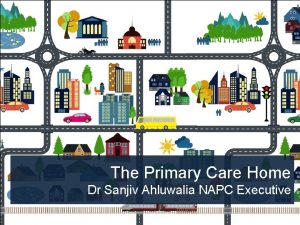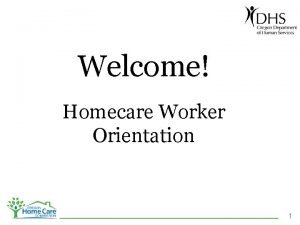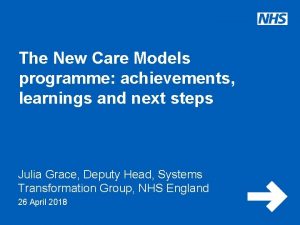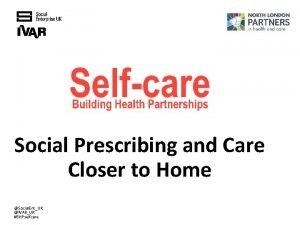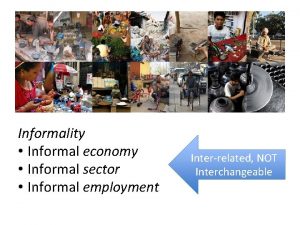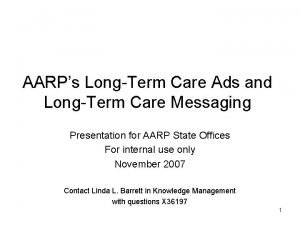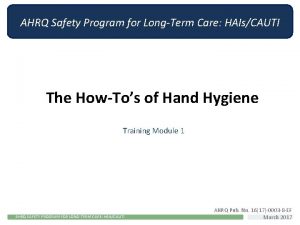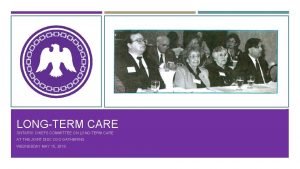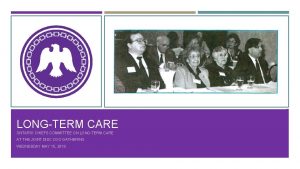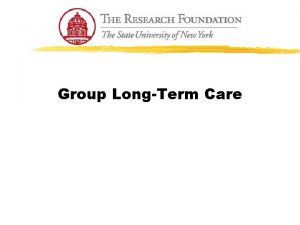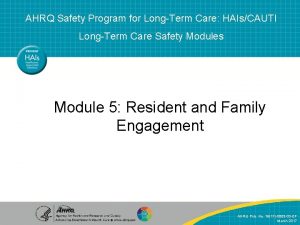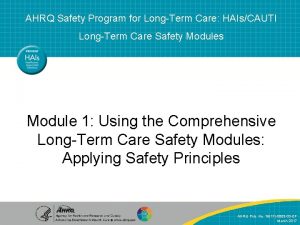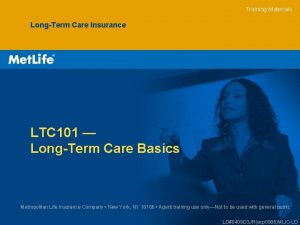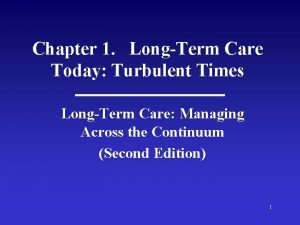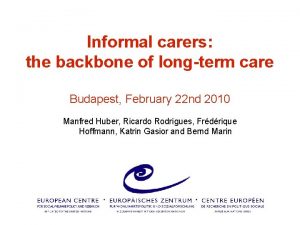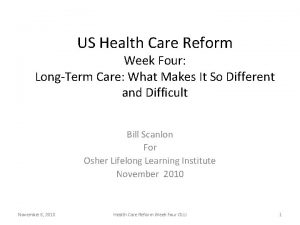Longterm Care Home Health Care and Informal Care


















































- Slides: 50

Long-term Care, Home Health Care, and Informal Care David Byrne, Michelle Goeree, Bridget Hiedemann, and Steven Stern October 2005

Roadmap • • Introduction Medicaid Financing Rules Theoretical Model Data Econometrics Results Policy Experiments

Elderly Population Growth • Increased by 28% between 1980 and 1993 • Will reach 20% of population by 2025

Long Term Care Arrangements • Children are less likely to care for elderly parents • Elderly parents are more likely to remain independent, move to a nursing home, or receive formal care • Data from 84 NLTCS indicate that siblings often share LTC responsibilities.

Previous Literature • Models with one child, one caregiver, or household utility function • Joint modelling of care and labor force participation • Intergenerational transfers and household formation • Game theoretic • Nonstructural estimation vs structural

Models with one child • Kotlikoff and Morris (1990) • Pezzin and Schone (1997, 1999) • Sloan, Picone, and Hoerger (1997)

Single household utility function • Hoerger, Picone, and Sloan (1996) • Kotlikoff and Morris (1990)

Joint modelling of care and labor force participation • Ettner (1996) • Pezzin and Schone (1997, 1999)

Intergenerational transfers and household formation • Hoerger, Picone and Sloan (1996) • Pezzin and Schone (1999)

Game theoretic • Pezzin and Schone (1997, 1999) • Sloan, Picone, and Hoerger (1997)

Nonstructural estimation • • • Kotlikoff and coauthors (1988, 1990) Wolf and Soldo (1988) Lee, Dwyer, and Coward (1990) Cutler and Sheiner (1993) Ettner (1996) Hoerger, Picone, and Sloan (1996, 1997) Norgard and Rodgers (1997) White-Means (1997) Couch, Daly, and Wolf (1999)

Structural estimation • Kotlikoff and Morris (1990) • Pezzin and Schone (1997, 1999)

Focus on single caregiver • • Cantor (1983) Stoller and Earl (1983) Horowitz (1985) Barber (1989) Kotlikoff and Morris (1990) Miller and Montgomery (1990) Pezzin and Schone (1997, 1999)

My Work with Coauthors • • Stern 1994, 1995, 1996 Hiedemann and Stern 1999 Engers and Stern 2001 Neuharth and Stern 2002

Medicaid Rules • Eligibility is linked to actual or potential receipt of cash assistance under SSI or former AFDC. Law generally requires states to cover these individuals. But states have some flexibility in determining their programs.

Coverage depends upon : • Categorically needy (12 states in 1993) • Elderly who are not poor by SSI or SSP standards but need assistance with medical expenses (37 states in 1993) • Individuals in medical care institutions or needing home care (over 40 states in 1993)


Theoretical Model • I adult children and one or two elderly parents • Assume that married couples act as a single player; therefore, there are I+1 players indexed by i=0, 1, 2, . . , I • When indexing married spouses, we use m (maternal) and p (paternal) for parents and c (child) and s (spouse) for children

Theoretical Model • Each player makes decisions about consumption Xi, contributions to paid help for the parent Hi, leisure Lik, time spent caring for each parent tipk and tifk, and market work time k=c, s for children and their spouses • Market work time is zero for both parents. For the children and their spouses, market work time is 1 -Lik-Σjtijk.


• The coefficients β 1 i, β 2 i, β 3 ik, and β 4 jik are deterministic functions of observed child characteristics • The errors εXi, εLik, and εtijk are functions of unobserved child characteristics • It is assumed that β 1 i≥ 0, β 2 i≥ 0, β 3 ik≥ 0, εXi ≥ 0, and εLik ≥ 0,

Budget Constraint • For each child,

Budget Constraint • We estimate Yi and s using CPS data and allow it to vary across states • For the parent, the budget constraint is Y 0+G 0≥p. X 0 X 0+q. H 0 if she is not eligible for Medicaid reimbursement of home health care expenses. If she is eligible, the budget constraint is equal to Ψ-max(q. H 0 -q. H) ≥ p. X 0 X 0 • 1 ≥L 0 k+t 0 jk

Consumption • For each child and parent, we can solve for Xi using the budget constraint to get

Formal Care Payments • For each player other than the parent, the set of FOCs for Hi is

Formal Care Payments • If ∂Ui/ ∂Hi<0, then FOC implies

Formal Care Payments • If ∂Ui/ ∂Hi=0, then FOC implies

Informal Care Hours • The FOCs for tijk depend on Hi. If Hi>0,

Informal Care Hours • If Hi=0,

Leisure

Data • Asset and Health Dynamics Among the Oldest Old (AHEAD) data set. • AHEAD is a nationally representative longitudinal data set designed to facilitate study of Americans 70 or older. • Emphasis on the joint dynamics of health, family characteristics, income, and wealth • Response rates are over 80%. • Blacks, Hispanics, and Florida residents are oversampled.

Selection criteria • We use 2, 876 households out of approximately 6, 000 • We use the first wave of data collected in 1993 • 1, 822 were dropped because their records were missing data on the respondent, the respondent's spouse, or the respondent's children.

Selection criteria • Households with working respondents (270) or two respondents each of whom helped the other (25) were dropped • Only the black and white non-Hispanic groups were sufficiently large to be included once households were dropped for the reasons listed above

Selection criteria • Households included in AHEAD contain at least one respondent 70 years old or older. • Many households also include spouses, some of whom are less then 70 years old. • Spouses of respondents are, themselves, respondents

Descriptive Statistics • Among 65% of 2876 households reporting receipt of paid help in their homes, average payment was $31/week and maximum was $570/week • 58% of households reported receiving some help from kids (avg: 22 hours/week) • Men (37% of sample) are, on average, 77 years old, have 11. 7 years of education, have 2 living children; 72% are married, and 93% are white

Descriptive statistics • Women (63% of sample) are, on average, 77 years old, have 11. 8 years of education, have 2 living children; 42% are married, and 90% are white • 19% of men and 24% of women have an ADL • 49% of children are male, 71% are married; avg kid is 47 years old with 2 children • Imputed wages using CPS: avg imputed wage is $510/week • Other state-specific variables: price level (BEA); cost of home health care; avg home health care state subsidy (HCFA)

Empirical Specification

Empirical Specification

Empirical specification • β 30 k and β 4 j 0 k can not be identified separately because the parents’ leisure time is determined jointly with their caregiving time. Thus, we set β 30 k=0 with no loss in generality. • Increasing all of the β terms by the same proportion has no effect on choices. Thus, we set β 2 i=1.

Empirical Specification

Identification • Inclusion of “happy” variable allows us to decompose informal care effects into burden and quality of care effects. • For example, if we were to observe that the provision of informal care by children has a very small empirical effect on the parent's happiness relative to the effect of variables affecting Z, we would conclude that α is very small and β 4 i >0. • Alternatively, if we were to observe that very little informal care is provided but those parents who receive it are usually happier, we would conclude that α is large and β 4 i <0.

Estimates with Variation in log α and β 4 (Parent Characteristics) Variable Estimate on log α Estimate on log. Z Estimate on β 4 Estimate on log β 1 Constant -5. 089** -3. 203** -4. 186** -0. 722** Age/100 -0. 864** -3. 121** 0. 913 Education -0. 020** White 0. 115 -0. 009 -0. 236 Married 0. 331** #ADLs -0. 165** -0. 287** -0. 280** Mother 0. 353** 0. 184 0. 116 Spouse Characteristics Age/100 2. 599** #ADLs -0. 095**

Estimates with Variation in log α and β 4 (Child Characteristics) Variable Estimate on log α Estimate on β 4 Estimate on log β 1 Estimate on log β 3 Constant -0. 752** -5. 333** 1. 113** 0. 346** Age/100 -0. 918** 9. 933** Male 0. 389** -1. 262 Biological 0. 110 -0. 376 Biological* Male -0. 449** 0. 851 Education 0. 002 -0. 178** Married 0. 401* -11. 539** #Kids 0. 053** -0. 317** Oldest -0. 048 0. 245

Estimates with Variation in log α and β 4 (Other Parameters) Variable Estimate logμ -10. 153** logσηt 0. 890** γ -5. 846** logσu 11. 974** logβ 0 12. 155** ρL 0. 900 logσηX -0. 037 ρt 0. 900 logσηL 0. 221

Goodness-of-fit Results





Policy Experiments • Provide a subsidy of q. F to each parent that must be used formal care (formal care stamps) • Provide a subsidy of F to each child for each unit of time she provides informal care • Provide a subsidy of F for each dollar spent on formal care (reduction in the price of formal care) • Provide a lump sum of F to the parent • Increase the income limit for Medicaid • Provide a subsidy of q. F to each parent for each ADL problem that must be used formal care.
 Lts kernel
Lts kernel Thomas silverstein
Thomas silverstein Apa arti homecare
Apa arti homecare Perbedaan home care dan home visit
Perbedaan home care dan home visit Health and social care component 3
Health and social care component 3 Home health care definition
Home health care definition Mobile home parks for sale in sc
Mobile home parks for sale in sc Unit 3 home sweet home
Unit 3 home sweet home Softly and tenderly jesus is calling
Softly and tenderly jesus is calling New mobile home sales oak springs mobile home community
New mobile home sales oak springs mobile home community America my home sweet home
America my home sweet home Jr rabbin imam pretre
Jr rabbin imam pretre She said that, home economics stands for the ideal home.
She said that, home economics stands for the ideal home. Home sweet home survive items
Home sweet home survive items Health and social care values unit 2
Health and social care values unit 2 Lenguaje inculto formal
Lenguaje inculto formal Veterans directed home and community based care
Veterans directed home and community based care Veterans directed home and community based care
Veterans directed home and community based care Unilever home care
Unilever home care S and a unified home care
S and a unified home care Person helping someone
Person helping someone Home visit assignment
Home visit assignment 3 phases of home visit
3 phases of home visit Why is community health important
Why is community health important Learning task 2 look for a health product at home
Learning task 2 look for a health product at home Pdgm home health occupational therapy
Pdgm home health occupational therapy Healthfinder florida
Healthfinder florida Ambient home health
Ambient home health Health care levels primary secondary tertiary
Health care levels primary secondary tertiary West yorkshire health and care partnership
West yorkshire health and care partnership Humber, coast and vale health and care partnership
Humber, coast and vale health and care partnership An example of appraisal in health and social care
An example of appraisal in health and social care Verna williams and sam williams
Verna williams and sam williams Difference between health promotion and health education
Difference between health promotion and health education Chapter 3 health wellness and health disparities
Chapter 3 health wellness and health disparities Difference between health education and propaganda
Difference between health education and propaganda Chapter 1 lesson 2 what affects your health
Chapter 1 lesson 2 what affects your health Understanding your health and wellness chapter 1
Understanding your health and wellness chapter 1 Ruang lingkup home care
Ruang lingkup home care Ohio home care waiver
Ohio home care waiver Mekanisme pelayanan home care
Mekanisme pelayanan home care Hbyc training for asha
Hbyc training for asha Pengertian homecare
Pengertian homecare Napc primary care home
Napc primary care home Ohiohcbs.pcgus.com
Ohiohcbs.pcgus.com Oregon homecare registry
Oregon homecare registry Care closer to home
Care closer to home Care closer to home
Care closer to home Care closer to home
Care closer to home Barry laird
Barry laird Eton house care home
Eton house care home

















